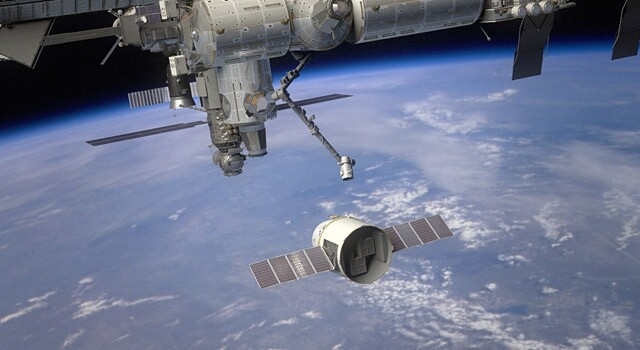In a stunning nightime launch at 3:44 Eastern Daylight Time, Elon Musk's Space Exploration Technologies (SpaceX) has sent the Dragon spacecraft into orbit on its way to a rendezvous with the International Space Station (ISS). The Dragon will deliver about 460 kilograms of cargo, including food, disposables, several nanocubes for small-scale experimentation and blocks of ice.
Both the Dragon spacecraft and its Falcon 9 launch rocket were designed and constructed by SpaceX. The company has been working toward this moment for over six years under contract to NASA's Commercial Orbital Transportation Services (COTS) program, whose goal is to provide the United States with safe, reliable, and inexpensive cargo delivery services to and from the ISS.
The first orbital flight of the Falcon 9 vehicle was in December 2010, establishing that SpaceX could launch, orbit, and recover a payload contained in SpaceX's Dragon capsule. The current mission will prove that Dragon can rendezvous and link up with the International Space Station.
The Falcon 9/Dragon was launched from Cape Canaveral Air Force Station in Florida. Some 10 minutes after launch, the Dragon reached a preliminary orbit, whereupon its solar arrays were successfully deployed.
The initial elliptical orbit varies from about 300 km to 450 km (217-280 miles) above the Earth's surface.
Dragon's inboard thrusters will undertake a series of burns to change its orbit and rendezvous with the ISS on Friday.

On reaching a rendezvous orbit, the ISS crew will take over the Dragon spacecraft, maneuver it to a position within reach of the Canadian ISS robotic arm, which will guide the Dragon to an ISS access hatch, onto which the Dragon will be latched by the crew to allow unloading and reloading under shirtsleeve conditions.

After analyzing the air inside the Dragon to discover if any contaminants have been released during the launch process, the ISS crew will open the access hatch, and begin unloading the Dragon's cargo. This is expected to take about 25 hours over a two week period. Dragon is carrying 460 kg (1014 lbs) of non-critical cargo to the station - non-critical because this is considered a test flight. It will bring back about 620 kg (1367 lbs) on its reentry and return to Earth.
About four hours after Dragon carefully maneuvers away from the ISS for deorbiting, it will conduct a seven minute long deorbit burn. In the next half four following the deorbit burn, the Dragon will splash down in the Pacific Ocean about 450 km (250 miles) west of Southern California on the US West Coast, where it will be recovered by a small fleet of SpaceX ships. The landing location is controlled by firing the Draco thrusters (each capable of 400 N (90 lbs) of thrust) in a carefully orchestrated sequence during reentry.

Dual drogue parachutes which stabilize and slow the descent of the Dragon are deployed at 13.7 km (44,000 feet) altitude. The drogue chutes also pull out the three main parachutes, each 35 m (116 feet) in diameter at about 3 km (10,000 feet) above the ocean. The main parachutes slow the splash down of the Dragon capsule for a soft landing (5-6 meters per second, or 16-19 feet per second). In the event of a parachute failure, Dragon is designed to be able to make a nominal landing using only two main parachutes.
Much of historical SpaceX orbital ISS supply mission plan still remains to be carried out, and Gizmag will keep you apprised of new developments. However, in the words of famed science-fiction writer Larry Niven: when you are in low Earth orbit, you are halfway to anywhere.
We wish the SpaceX/NASA team the best of fortune on the remainder of this journey.
NASAtv coverage of the launch can be seen below.




















